|
|
|
Sort Order |
|
|
|
Items / Page
|
|
|
|
|
|
|
| Srl | Item |
| 1 |
ID:
169346
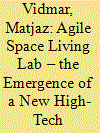

|
|
|
|
|
| Summary/Abstract |
The global space industry has recently seen a structural transformation through the emergence of ‘New Space’, i.e., a significant expansion of the development of smaller, cheaper, and more modular space-related products in services. One example of this expansion is the emergence of a world-leading cluster of New Space industry in Scotland (UK). Critically, this development is being pitched as a new approach to innovation ecosystem, which the players refer to as ‘Agile Space’, based on a consolidation of cross-sector competences within loose value chain integration. However, I argue, in particular, that the emergence of the Scottish New Space Sector is crucially linked to the Living Laboratories (Living Lab) conceptualisation of the innovation practices and processes within the Agile Space approach. Hence, this article maps the key features of the emergence and development of the New Space Industry in Scotland and analyses the key feature of the Agile Space Living Lab paradigm, before proposing a critical further research agenda suggesting several much-needed strands of enquiry.
|
|
|
|
|
|
|
|
|
|
|
|
|
|
|
|
| 2 |
ID:
169342


|
|
|
|
|
| Summary/Abstract |
Iran has a long-standing and increasingly comprehensive space program. Given the current technological and political developments worldwide, a logical next step is to start commercializing some of the country's space activities. After first reviewing the literature on the commercialization of technology, this article describes Iran's space program and the various organizations involved in it, before presenting research based on interviews with 15 experts in the field of space commercialization. The results suggest that there are eight areas that Iran should concentrate on but that there are also currently several barriers to commercialization of the country's space industry. A conclusion provides recommendations for facilitating commercialization in the future.
|
|
|
|
|
|
|
|
|
|
|
|
|
|
|
|
| 3 |
ID:
169348


|
|
|
|
|
| Summary/Abstract |
Commercial space transportation (CST) will occur in the foreseeable future. After the success of Virgin Galactic's first suborbital commercial human spaceflight in 2004, many believed that our generation will explore another frontier of technology. Despite technological advancements, however, the international law currently in place is not prepared to regulate and secure the safety of CST including human spaceflights. Previous legal studies mainly focused on finding ways to accommodate CST under existing international laws, air law, or space law regime. Nevertheless, more than fifty years of legal discussion have yet to yield a decisive solution. Against the odds, CST will commence its business sooner or later. While national laws would be sufficient in many CST operations, some operations (e.g., international flight) would require international rules to secure a safe CST operation akin to what the aviation community developed for international air transport. That mechanism is encompassed in the technical standards created by the International Civil Aviation Organization. In this respect, this study aims to analyze a way to generate internationally harmonized technical standards on CST activities, with or without achieving an international law for CST. First, the article analyzes past legal discussion to understand the landscape of future aerospace activities. Then, the study reviews the history of the international aviation legal regime to find the implications of creating internationally harmonized technical standards for CSTs. The study suggests to the international community first, to forge a common ground across countries and second, that qualitative (not quantitative) international technical standards should arise based on this mutual understanding.
|
|
|
|
|
|
|
|
|
|
|
|
|
|
|
|
| 4 |
ID:
169349


|
|
|
|
|
| Summary/Abstract |
The extreme conditions of all extraterrestrial environments restrict freedom of movement and encourage social, political and economic arrangements friendly to tyranny. However, deliberately engineered measures might be taken to maximise liberty in the space environment. For example, space settlements can be engineered to maximise the number of oxygen, food, water and power systems to disallow coercive regimes the opportunity to control single machines on which entire settlements depend. Spacesuits can be engineered to be easily manufactured and maintained, thus maximising the number available to occupants of a settlement and minimising the extent to which bespoke and difficult-to-service suits restrict freedom of movement. Other examples of this approach to engineering are provided, which we might term ‘freedom engineering’. Although attempts to deliberately engineer freedom into a settlement turn on the definition of ‘freedom’, it is suggested that objective criteria in the enhancement of certain types of individual and collective liberty can be used to determine when an act of freedom engineering is likely to be beneficial for a settlement. The space policy implications of these ideas are discussed.
|
|
|
|
|
|
|
|
|
|
|
|
|
|
|
|
| 5 |
ID:
169350
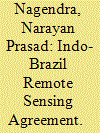

|
|
|
|
|
| Summary/Abstract |
Capabilities in space technology are turning into a corner stone of emergence of developing countries such as India and China. In a string of agreements for cooperation in outer space, India has developed several cooperation mechanisms with international partners to harness the benefits of space technology for mutual benefits. India has recently signed a multitude of cooperative agreements in outer space and these instruments of cooperation have advanced the space based capabilities and have mutually benefitted the partners. In one such recent engagement, India has signed a bilateral cooperation Memorandum of Understanding with Brazil in the implementation of an arrangement establishing cooperation in the augmentation of a Brazilian Earth station for receiving and processing the data from Indian Remote Sensing satellite. The agreement has been based on the interest of Brazil to receive the Resourcesat-2 data for natural resources management, but not limited to it. In the backdrop of the agreement between India and Brazil, the present work presents an analysis of the state of capacities for these countries and an overview of policy implications for India. In a foreign policy perspective, the Indo-Brazil agreement has been timed at a stage when the Sino-Brazil cooperation is faced with a challenge of recent failure and is set to provide India a push into a better South–South cooperation. The agreement has provided India an added location to downlink its satellite data and may well lay a foundation for future cooperation with other Latin American States and for further global strengthening of ties in forums such as the IBSA.
|
|
|
|
|
|
|
|
|
|
|
|
|
|
|
|
| 6 |
ID:
169345
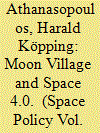

|
|
|
|
|
| Summary/Abstract |
This article discusses the Moon Village concept within the context of the increasing momentum to return human beings to the surface of the Moon. The article follows a dual objective. Firstly, the Moon Village is probably the most misunderstood among the plethora of ideas to explore the Moon scientifically and commercially. The article is therefore intended to explore what the Moon Village actually is. Secondly, the article explores the strengths and weaknesses of the Moon Village. The article is divided into three sections. The first section reviews the current Moon projects of public and private space actors, including the United States, Russia, China, SpaceX and Blue Origin. It sets the scene for the argument that the Moon Village has entered global discourse on space within a positive political environment. The second section discusses the premises of ESA chief Jan Wörner’s Moon Village concept, putting forward that the Moon Village is intended as an open concept rather than as a concrete plan. It is a process rather than a project and it is meant to initiate a global conversation on humanity’s future on the Moon. As such, the world café is an appropriate metaphor to illustrate the idea behind the Moon Village. In the third and final section a SWAT/PEST analysis is conducted to assess the feasibility of the Moon Village, highlighting that one of the major opportunities of the project is to promote international cooperation. The article concludes by supporting the institutionalist hypothesis that the Moon Village is arguably a translation of the ESA system to the global level, as participation is voluntary and as it builds on the strengths of each cooperation partner. As such, the Moon Village in indeed a new way of doing space on the global level.
|
|
|
|
|
|
|
|
|
|
|
|
|
|
|
|
| 7 |
ID:
169347
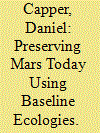

|
|
|
|
|
| Summary/Abstract |
Current calls to protect the Martian environment with “Planetary Parks” maintain environmental merit. However, they lack a sufficiently urgent timeframe for initiating protection and a robust scientific method for the establishment of noteworthy Martian natural landmarks as natural reserves. In response, if we return to the seminal environmental preservation teachings of Aldo Leopold and John Muir, we encounter the importance of grounding Martian preservation efforts on the fundamental environmental science method of a base-datum of normality, or baseline ecology. This method establishes natural reserves that feature both minimal human interference and known origination dates, thereby providing longitudinal environmental control samples for scientific use. Applied before humans appear on Mars, preserved baseline ecologies thereby aid our scientific understanding of human environmental impacts, both now and well into the future, while they enhance a variety of other outcomes in terms of Martian protection. However, the baseline ecology method requires that, through international agreements, we establish these reserves as quickly as possible and certainly before humans arrive on the planet.
|
|
|
|
|
|
|
|
|
|
|
|
|
|
|
|
| 8 |
ID:
169340
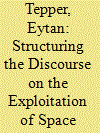

|
|
|
|
|
| Summary/Abstract |
A critical discussion is reemerging in space policy, economics, and law: on the classification, use and possible ownership of space resources, and the governance of these activities in terms of rules and institutions. The US legislation from 2015, recognizing the right of US citizens to all asteroid resources they obtain, clearly signals that “money time” has come, in every meaning. Planetary Resources, Inc. has declared this new legislation “the single greatest recognition of property rights in history”. Yet, the discourse on space resources, which are widely—but not necessarily duly—regarded as “commons”, is unstructured and crippled by the confusion of the notion and essence of “commons” between the economic and the legal meanings. This article provides a critical analysis of the “commons” feature of outer space and outer space resources, based on economic analysis and legal theory. More importantly, this article seeks to provide the structure for this important discourse. The first critical step is to distinguish between (i) commons as an economic term and (ii) commons as a legal regime. The first refers to a type of goods or resource used by multiple users, and the second refers to a property rights regime, the ownership over the resource. A mistake, often made, is the confusion between the economic notion of “commons” and the legal sense of the same concept. An “economic commons”, such as a lake, may have different property rights regimes as it may be private property, government property, or “legal commons”. The second critical differentiation is between the different parts of space (e.g. orbits, celestial bodies, and void space) because some may be “commons” (economic and/or legal) while others may not. Asking whether “space” is commons wrongly puts numerous things in a single basket is a sweeping generalization and, in the economic sense, utterly meaningless. Another important distinction is between resource systems and resource units. If we get the questions wrong, i.e. by confusing the terms and mixing different subjects of inquiry, we will not, by definition, find the right answers. Furthermore, the article demonstrates that the notion of “global commons”, often applied to outer space, is of limited or unclear meaning, and it does not imply the property rights regimes in the domains and resources it presumably describes, including outer space. The article opens with making the aforementioned three distinctions in section two. Sections three and five present, separately, the economic and legal notions of “commons” and examine whether some parts of space qualify as economic and/or legal commons, whereas section four presents the limitations of the notion of “global commons”, thus leading to section five. The article concludes by connecting the economic and legal discussions to the search for appropriate governance models for each part of space. As the article demonstrates, the real questions in the discourse are much more complex than “is space commons?”. Although this article provides preliminary answers to the questions it raises, its main contribution is the reshaping of the question(s) currently being asked and the structuring of the discourse on space resources and their governance.
|
|
|
|
|
|
|
|
|
|
|
|
|
|
|
|
| 9 |
ID:
169343
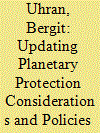

|
|
|
|
|
| Summary/Abstract |
Planetary protection, or the protection of celestial bodies from potentially harmful contamination, has been required by international law since the ratification of the Treaty on Principles Governing the Activities of States in the Exploration and Use of Outer Space in 1967. At that time, scientists were concerned about the potential of contaminating the Moon or bringing back a life form of lunar origin when astronauts returned to Earth with samples. The evidence is that the Moon does not contain indigenous life, but other celestial bodies may. Mars is of particular concern because of its habitability and plans to carry out a robotic sample return mission and even potentially human crewed missions in the near future (next 20–30 years). This article (recognizing that other national and international tasks are ongoing with detailed studies of technical aspects of containment and sample analysis) provides an overview of the policy aspects of planetary protection and sample return, discussing the history of planetary protection, lessons learned from the Apollo missions, and a potential strategy to ensure prevention contamination if a robotic sample return mission is carried out. It is recommended that the capability performed in the 1960s by the Interagency Committee on Back Contamination be reestablished, that regulations be developed to allow quarantine of anyone exposed to the samples, that scientific and technical personnel be trained in a receiving laboratory for at least 2 years prior to sample return, and that a test protocol be established for examining the samples. This will protect our biosphere while enabling groundbreaking research into conditions on Mars and any possible signs of life.
|
|
|
|
|
|
|
|
|
|
|
|
|
|
|
|
|
|
|
|
|